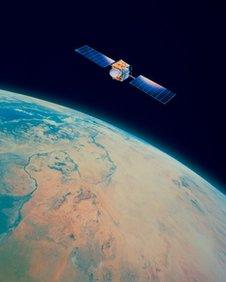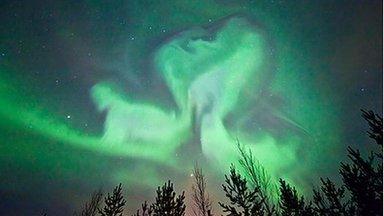System could warn of solar storms
- Published

Solar flares can send high energy particles streaming towards Earth
A warning system with the potential to protect against the devastating and costly effects of a massive solar storm could be on the horizon.
That's according to research published in the journal Astroparticle Physics, external.
Solar flares can be accompanied by the release of high energy particles - a coronal mass ejection - towards Earth.
Ensuing huge geomagnetic storms could wreak havoc on electronic systems, satellites, power grids and communication networks.
Data from the study, led by Prof Ephraim Fischbach and Prof Jere Jenkins of Purdue University, suggest that the rate of breakdown of radioactive materials changes in advance of solar flares.
They hope they can use this to develop a system that could predict when a potentially devastating geomagnetic storm might take place. This would allow authorities to adopt protective measures, such as shutting down satellites, at times of most risk.
But it is unclear how long such a system would take to develop. Prof Jenkins told BBC News: "We're still developing algorithms to pinpoint what type of flare and magnitude it will be."
Other physicists are more sceptical. Dr Paul Soler, a particle physicist at the University of Glasgow, commented: "The variation in the decay rate of different radioactive isotopes seems to be real." However, he thought that environmental effects, such as tempertature or humidity, might have affected instruments used to measure this.
He also thought cosmic ray variations could be the culprit - by inadvertently interacting with a key component of the instrument used to measure the radioactive decay. Dr Soler argued that "they should do similar experiments underground, where the cosmic ray rate is reduced dramatically to rule out such effects".

Satellites are at risk during powerful solar eruptions
Radioactive elements - such as uranium - are unstable and break down over time. As they do this they release energy in the form of radiation. Physicists have long held the view that the rate of breakdown - or decay - for any given radioactive substance is constant.
A chance event led Prof Jenkins to doubt this. He was watching television coverage of astronauts spacewalking at the International Space Station. A solar flare erupted and was thought to pose a risk to the astronauts. On checking equipment in his laboratory, he was surprised to discover that the rate of radioactive decay changed before the solar flare.
The current report follows years of painstaking research designed to strengthen this initial observation. "It's the first time the same isotope has been used in two different experiments at two different labs, and it showed basically the same effect," Prof Fischbach said.
It is unclear how solar particles affect rates of radioactive decay, but Prof Jenkins asserts that "either neutrinos are affecting the decay rate or perhaps an unknown particle is". Neutrinos are subatomic particles; huge numbers of them are spewed out during a solar flare.
Dr Soler was not convinced by the neutrino theory: "Neutrinos very rarely interact with other things - if your detector was one tonne, you would have to wait on average four years to see one interaction! I believe that neutrinos cannot be the explanation for this."
One of the biggest geomagnetic storms on record was the Carrington event of 1859. According to Prof Fischbach: "There was so much energy from this solar storm that the telegraph wires were seen glowing." He pointed out that "because we now have a sophisticated infrastructure of satellites, powergrids and all sorts of electronic systems, a storm of this magnitude today would be catastrophic. Having a day and a half warning could be really helpful in averting the worst damage".
According to the Union of Concerned Scientists, external, there are around 1,000 satellites in operation above the Earth's atmosphere. Satellites are used for communication, weather forecasting, navigation, research and reconnaissance.
Solar activity fluctuates over an approximate 11-year cycle. Activity is likely to peak over the next year or so and could bring strong solar storms.

The aurora borrealis lights up the winter sky
Solar particles also produce one of nature's wondrous spectacles - the auroras - natural light shows in the Earth's atmosphere. The auroras visible in the northern and southern hemispheres are known as the Aurora Borealis (Northern Lights) and Aurora Australis (Southern Lights), respectively.
The auroras are most visible at high latitudes - usually in the polar regions. However, the intensity of this light show is influenced greatly by the amount of solar flare activity. According to Prof Fischbach, "the aurora borealis appeared as far south as Cuba" during the famous Carrington event.
- Published9 March 2012
- Published24 January 2012
- Published9 March 2012